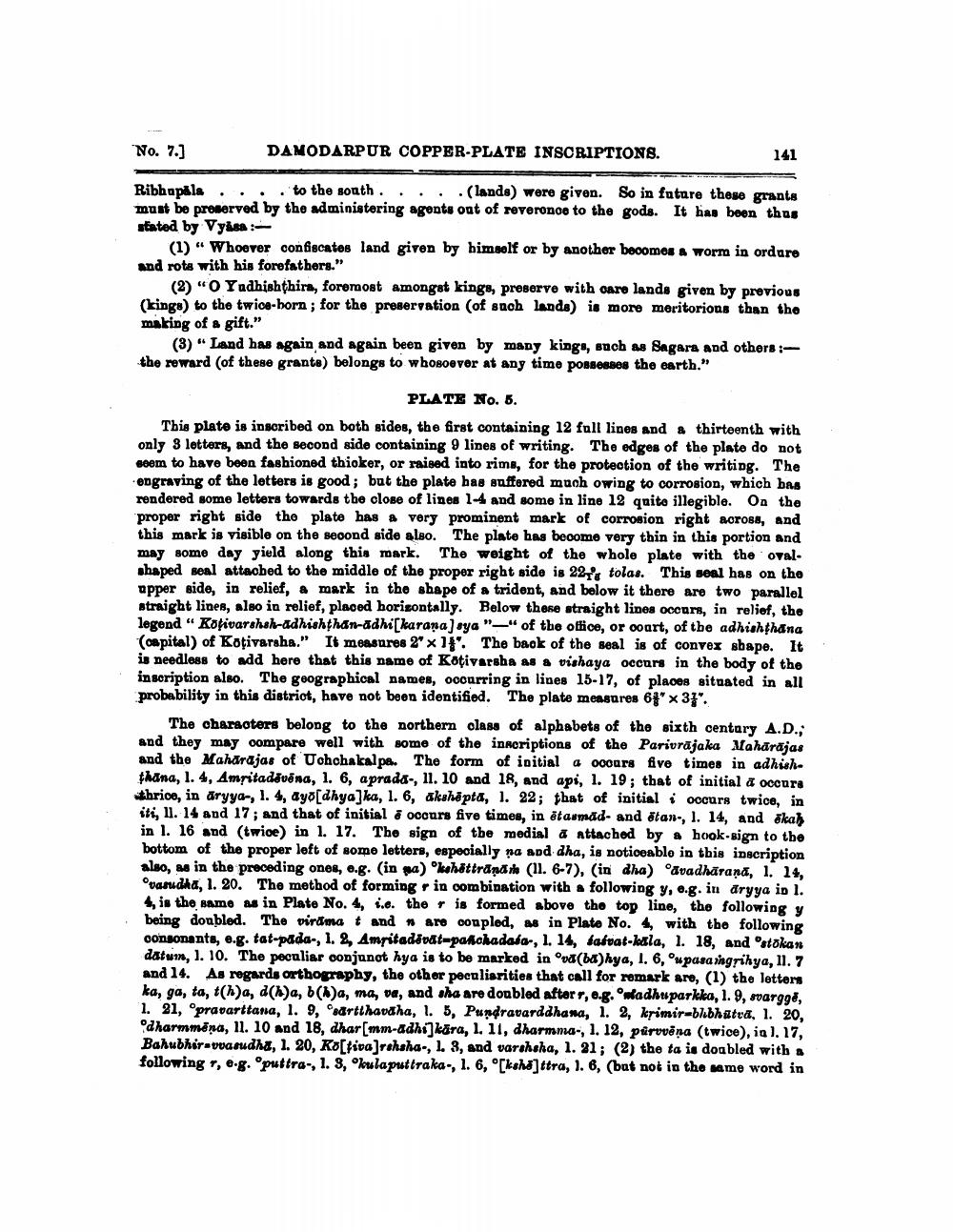________________
No. 7.]
DANODARPUR COPPER-PLATE INSCRIPTIONS.
141
Ribhapala .. .. to the south.. .. .(lands) were given. So in future these grants must be preserved by the administering agents out of reveronoe to the gods. It has been thus stated by Vyasa :
(1) “ Whoever confiscatos land given by himself or by another beoomos A Worm in ordare and rots with his forefathers."
(2) "0 Yadhishthira, foremost amongst kings, preserve with oare lands given by previous (kinge) to the twice-born; for the preservation (of such lands) is more moritorions than tho making of a gift."
(3) " Land has again and again been given by many kings, such as Sagars and others :the reward (of these grants) belongs to whosoever at any time possesses the earth."
PLATE No. 5.
This plate is inscribed on both sides, the first containing 12 full lines and a thirteenth with only 8 letters, and the second side containing 9 lines of writing. The edges of the plate do not seem to have been fashioned thioker, or raised into rims, for the protection of the writing. The engraving of the letters is good; but the plate has suffered much owing to corrosion, which bas rendered some letters towards the close of lines 14 and some in line 12 quito illegible. On the proper right side the plate has a very prominent mark of corrosion right across, and this mark is visible on the second side also. The plate has become very thin in this portion and may some day yield along this mark. The weight of the whole plate with the oval. shaped seal attached to the middle of the proper right side is 227 tolas. This seal has on the apper side, in relief, a mark in the shape of a trident, and below it there are two parallel straight lines, also in relief, placed horisontally. Below these straight lines occurs, in relief, the legend " Kotivarshsh-adhishthan-adhi[karana) sya "_" of the office, or ooart, of the adhishthana (ospital) of Kotivaraha." It measures 2 x 14" The back of the seal is of convex sbape. It is needless to add here that this name of Kotivarsha as a vishaya occurs in the body of the inscription also. The geographical names, occurring in lines 15-17, of places situated in all probability in this district, have not been identified. The plate measures 69" x 37".
The characters belong to the northern class of alphabets of the sixth centary A.D.; and they may compare well with some of the inscriptions of the Parivrajaka Mahārājas and the Maharajas of Uchchakalpe. The form of initial a oooars five times in adhishthana, l. 4, Amritaddvana, 1. 6, a prada., 11. 10 and 18, and api, 1. 19; that of initial a occurs thrice, in äryya, 1. 4, dyo[dhya]ka, 1. 6, akshēpta, 1. 22; that of initial i cocurs twice, in iti, 11. 14 and 17; and that of initial i occurs five times, in tasmad- and itan, I. 14, and ēka) in l. 16 and (twioe) in l. 17. Tho sign of the medial a attached by a hook-sign to the bottom of the proper left of some letters, especially na apd dha, is noticeable in this inscription also, as in the preceding ones, e.g. (in pa) kehättränare (11. 6-7), (in dha) avadhārana, 1. 14, vasudha, 1. 20. The method of forming in combination with a following y, o.g. in dryya ip l. 4, is the same as in Plate No. 4, s.c. ther is formed above the top line, the following y being doubled. The virama t and are coupled, as in Plate No. 4, with the following consonants, e.g. tat-pada-, 1.2, Amritadivdtpalichadaha, 1. 14, safuat-kala, 1. 18, and stokan datun, 1. 10. The peculiar conjunot hya is to be marked in ovd(bahya, I. 6.°-pasaningsihya, 11. 7 and 14. As regards orthography, the other peculiarities that call for remark are, (1) the letters ka, ga, ta, t(h)a, d(1) a, bla, ma, va, and sha are doubled after r, .g. Wadhu parkla, 1. 9, svargod, 1. 21, pravarttana, 1. 9, sartthavaha, l. 5, Pundravarddhana, 1. 2, krimir-bhbhatra, 1. 20, dharmmēna, 11. 10 and 18, dhar[mm-adhi]kära, 1. 11, dharmma-, 1. 12, pürvvëna (twice), in l. 17, Bahubhir-vvasudha, 1. 20, Ko[tivajrasha., l. 3, and varshsha, 1. 21; (2) the ta is doabled with a following , e.g. puttra , 1., lula puttraka., 1. 6,[kshd]ttra, 1. 6, (but not in the same word in




